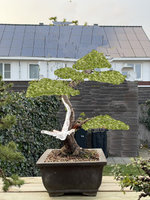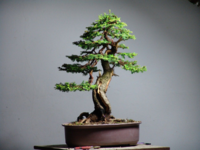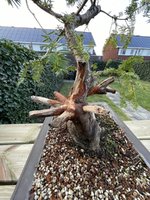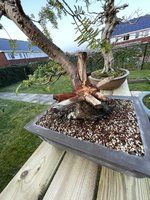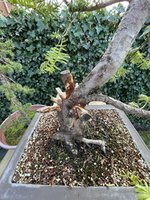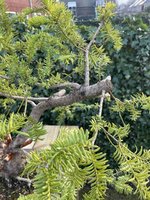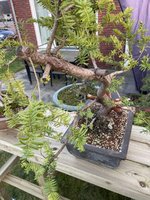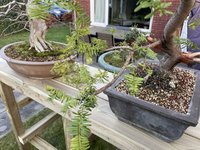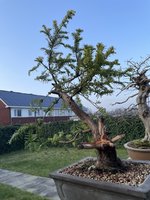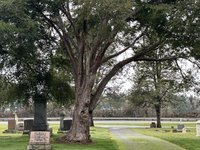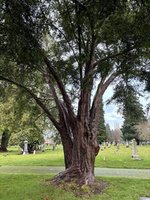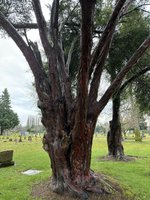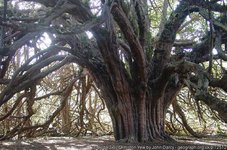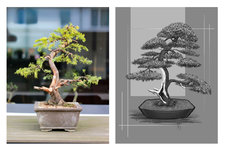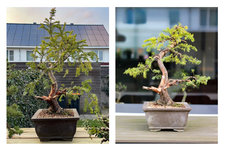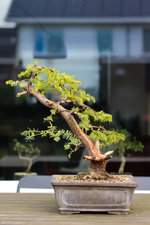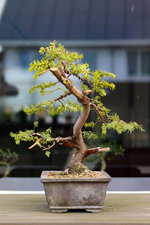RODERLO
Mame
Hi everyone,
I've recently acquired this unique and rather unconventional Yew (taxus cuspidata).
It's approx. 70 cm tall measured from the soil up.
It's got several stubs in circular formation around base of the trunk, which I think present some interesting possibilities for carving.
Not sure yet what I want with it. I could lean into the "king's crown" look that it has now, and create something artistic and unique. Thus veering away from a more naturalistic look.
Or I could try to make it look like a second trunk was lost to the tree, possibly carving it into a partially hollow trunk.
Regarding the branch structure, I think that's where the real challenge is with this tree. Obviously, the main trunk is long, with little taper. It has been chopped abruptly at the end.
Secondly, the position of the branches aren't optimal. However I would really like to try and work with it. I think we often decide doing drastic chops/reduction too easily without considering the tree's unique properties and leaning into them.
I would love to take this tree somewhere interesting, perhaps even controversial, rather than conventional.
So please let your minds run wild with ideas for this one!
The tree is oriented in the pot like this right now:
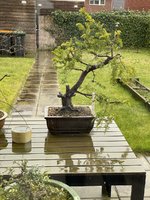
As you can see, most branches are positioned on the top of the trunk and flowing back down the trunk.
I am however considering using this as a front: basically turning it 90 degrees in the pot.
There is a lot more interesting movement to the trunk. Plus, the future deadwood would be more visible.
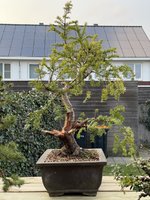
I'd be really curious to hear your ideas regarding the styling elements of this tree (carving the trunk, branch positioning, possible front and planting angle)!
Thanks!
I've recently acquired this unique and rather unconventional Yew (taxus cuspidata).
It's approx. 70 cm tall measured from the soil up.
It's got several stubs in circular formation around base of the trunk, which I think present some interesting possibilities for carving.
Not sure yet what I want with it. I could lean into the "king's crown" look that it has now, and create something artistic and unique. Thus veering away from a more naturalistic look.
Or I could try to make it look like a second trunk was lost to the tree, possibly carving it into a partially hollow trunk.
Regarding the branch structure, I think that's where the real challenge is with this tree. Obviously, the main trunk is long, with little taper. It has been chopped abruptly at the end.
Secondly, the position of the branches aren't optimal. However I would really like to try and work with it. I think we often decide doing drastic chops/reduction too easily without considering the tree's unique properties and leaning into them.
I would love to take this tree somewhere interesting, perhaps even controversial, rather than conventional.
So please let your minds run wild with ideas for this one!
The tree is oriented in the pot like this right now:

As you can see, most branches are positioned on the top of the trunk and flowing back down the trunk.
I am however considering using this as a front: basically turning it 90 degrees in the pot.
There is a lot more interesting movement to the trunk. Plus, the future deadwood would be more visible.

I'd be really curious to hear your ideas regarding the styling elements of this tree (carving the trunk, branch positioning, possible front and planting angle)!
Thanks!

